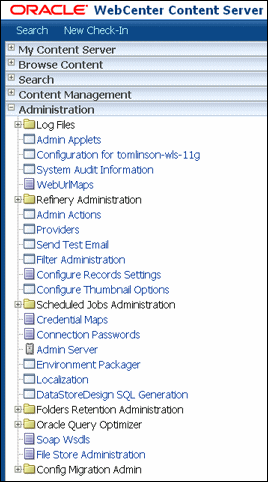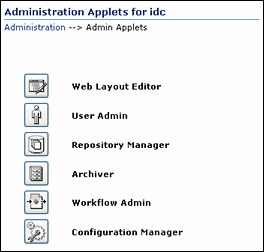| Oracle® WebCenter Content System Administrator's Guide for Content Server 11g Release 1 (11.1.1) Part Number E10792-04 |
|
|
PDF · Mobi · ePub |
| Oracle® WebCenter Content System Administrator's Guide for Content Server 11g Release 1 (11.1.1) Part Number E10792-04 |
|
|
PDF · Mobi · ePub |
This chapter provides an introduction to Oracle WebCenter Content Server (Content Server) and its administration tools. Subsequent chapters describe Content Server administration using Oracle WebLogic Server, Content Server system configuration processes and settings, administrative procedures for security, users, components, search tools, content migration, and archiving.
It is assumed that Oracle WebCenter Content (WebCenter Content) and Content Server software is already installed and ready for use.
For information on installing WebCenter Content software with a Content Server instance and setting initial post-installation configuration options, see Oracle WebCenter Content Installation Guide.
The following topics are covered:
Section 1.2, "Content Server Administrative Accounts and Responsibilities"
Section 1.4, "Content Server Administration Utilities and Applets"
Oracle WebCenter Content Server (Content Server) software enables organizations to share, manage, and distribute business information using a web site as a low-cost access point. Designed for the Web, this software is considered the unrivaled solution for medium to large companies for building secure business libraries with content check in, check out, revision control, and automated publishing in web-ready formats. Current information is available to authorized users anytime, anywhere. You can link virtually any type of file including letters, reports, engineering drawings, spreadsheets, manuals, sales literature, and more under one powerful system of knowledge distribution.
The Content Server software is designed for several types of users and administrators:
Consumers: Users who just need to find, view, and print files. In a typical system, the majority of the users are consumers. These users do not need a user name and password to access the content server system unless security is placed on the files.
Contributors: Users who need to create and revise files. To safeguard the integrity of the files, the contributors need a user name and password to check files in and out of the system.
Administrators: Administrators who oversee an entire instance. Administrator responsibilities include setting up, maintaining, and managing Content Server users, content, and system configurations. Common tasks for an administrator include configuring the system to manage and index files, archiving and replicating information, working with security, adjusting system properties, reviewing log files, and so forth.
Users and administrators must be set up on Oracle WebLogic Server for authentication; roles, groups and accounts can be assigned and modified in the Content Server instance as needed.
The Content Server administrator must be assigned an administrator role on the Oracle WebLogic Server Administration Console to have full administrative privileges for the Content Server instance and the Content Server Admin Server. The Content Server administrator can define system roles, permissions, and accounts to be assigned to Content Server users with the Oracle WebLogic Server Administration Console. A Content Server administrator is typically responsible for tasks including:
Configuring Content Server system settings and processes
Managing Content Server security configuration
Creating and managing user roles, user groups, and accounts
Managing Content Server system and custom components
Configuring Content Server search tools
Managing Content Server system migration and archiving
Monitoring and troubleshooting the Content Server instance
Additional tasks including managing Content Server applications. For details, see Oracle WebCenter Content Application Administrator's Guide for Content Server.
Oracle provides the following tools for managing the Oracle WebCenter Content Server instance:
Section 1.3.1, "Oracle Enterprise Manager Fusion Middleware Control Console"
Section 1.3.2, "Oracle WebLogic Server Administration Console"
An Oracle WebCenter Content Server administrator should use these tools, rather than edit configuration files, to perform administrative tasks unless a specific procedure requires you to edit a file. Editing a file may cause the settings to be inconsistent and generate problems.
The Oracle Enterprise Manager Fusion Middleware Control Console is a browser-based management application deployed when WebCenter Content is installed with a Content Server instance. Using the Oracle Fusion Middleware Control Console an administrator can monitor and administer a farm.
A farm is a collection of Oracle components managed by Fusion Middleware Control. A farm can contain a Managed Server domain and other Oracle Fusion Middleware system components that are installed, configured, and running on the domain. A Managed Server domain contains one or more Managed Servers running one or more applications, including the Oracle WebLogic Server Administration Console and Content Server instance.
Fusion Middleware Control organizes a wide variety of performance data and administrative functions into distinct, web-based home pages. These home pages make it easy to locate the most important monitoring data and the most commonly used administrative functions for a component, all from your web browser.
Fusion Middleware Control is the top-level management tool for WebCenter Content with a Content Server instance, and it can be used to:
Deploy, undeploy, and re-deploy WebCenter Content with a Content Server instance
Configure back-end services
Configure security management
Control process lifecycle
Export and import data
Access log files and manage log configuration
Manage migrations
Monitor performance
Diagnose run-time problems
The Oracle WebLogic Server Administration Console is a browser-based management application that you use to manage an Oracle WebLogic Server domain. The Administration Server hosts the Administration Console, which is a web application accessible from any supported web browser with network access to the Administration Server Managed Servers host applications.
The Administration Console can be used to:
Configure, start, and stop Oracle WebLogic Server domains
Configure Oracle WebLogic Server clusters
Configure Oracle WebLogic Server services, such as database connectivity (JDBC) and messaging (JMS)
Configure security parameters, including creating and managing users, groups, and roles
Configure and deploy applications
Monitor server and application performance
View server and domain log files
View application deployment descriptors
Edit selected run-time application deployment descriptor elements
Note:
When configuring a production environment, the Administration Console's Change Center requires that before making configuration changes the administrator must lock configuration settings for a domain by clicking Lock & Edit.
For more information about the Oracle WebLogic Server Administration Console, see "Displaying the Oracle WebLogic Server Administration Console" in the Oracle Fusion Middleware Administrator's Guide.
The Oracle WebLogic Scripting Tool (WLST) can be used to manage Oracle Fusion Middleware components, such as WebCenter Content with a Content Server instance, from the command line.
The WebLogic Scripting Tool is a command-line scripting environment for creating, managing, and monitoring Oracle WebLogic Server domains. It is based on the Java scripting interpreter, Jython. In addition to supporting standard Jython features such as local variables, conditional variables, and flow control statements, the WebLogic Scripting Tool provides a set of scripting functions (commands) that are specific to Oracle WebLogic Server instances. Administrators can extend the WebLogic scripting language to suit site-specific needs by following the Jython language syntax.
WebCenter Content with a Content Server instance offers custom WLST commands for managing Content Server application connections (to the repository, portlet producers, external applications, and other back-end services). All the WLST commands specific to WebCenter Content with a Content Server instance are described in the section "Oracle WebCenter Content Server Custom WLST Commands" in the Oracle Fusion Middleware WebLogic Scripting Tool Command Reference.
The Content Server provides specific administration utilities and applications for managing users, content, providers, archives, and so forth. This section includes the following:
See the browser considerations section in your installation and deployment guide for information about Java browser plug-ins and applet display issues.
The Content Server provides the following tools to configure and maintain system operation:
The following tools can be started only as standalone applications from the computer where the Content Server instance is installed:
Batch Loader: Update or check in a large number of content items simultaneously.
System Properties: Configure the system options and functionality of the content server.
Content Analyzer: Confirm the integrity of the Content Server repository components, including the file system, database, and search index.
ComponentWizard: Create and install custom components to modify Content Server behavior.
ComponentTool: Install and enable or disable components using the command line.
The following management pages can be accessed by using a web browser and choosing the Administration tray in the Content Server portal:
Admin Server: Configure system-wide settings and view Content Server status. A Content Server instance has its own Admin Server instance, which manages the Content Server instance on the WebCenter Content domain and Oracle WebLogic Server domain.
Providers: Add providers, configure provider information, and test providers.
The following applications can be started as standalone applications from the Admin Applets Page on a Content Server instance, as applets through a web browser, or from the Apps menu in each of the tools. For details on the applications, see Oracle WebCenter Content Application Administrator's Guide for Content Server.
Weblayout Editor: Build a web site, work with reports, write queries.
User Admin: Manage the local user base, set up security (by assigning roles and permissions to users), define aliases, and manage security groups.
Repository Manager: Perform file diagnostics, file management functions, search data re-indexing, and subscription management functions.
Archiver: Export, import, transfer, and replicate content server files and information. For details, see the chapter on managing system archiving and migration.
Workflow Admin: Set up workflows to route content to specific people for action.
Configuration Manager: Manage content types, file formats, and custom metadata fields.
The Administration tray is the default layout in Content Server to provide access to administration log files and to screens for configuring and managing Content Server applications and tools. To access the Administration tray, log in as a Content Server administrator, then choose Administration to view available administration options. If your Content Server instance is configured to use Menus, choose Administration to view the same options in a menu layout.

The Admin Applets page provides access to Content Server administration applets and configuration tools. To access this page, log in as an administrator and choose Administration then Admin Applets.

Note:
You may experience problems if you start any Java applets (such as a Content Server administration applet or the multiple-file upload applet) from a browser that is using Sun's JDK 1.3/1.4 Java plug-in. These issues are related to authentication when launching an applet for the first time and applets closing when the parent window is changed.